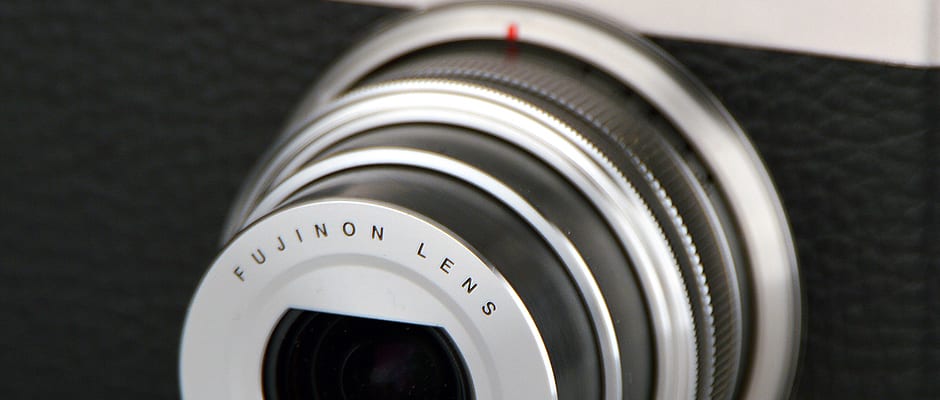Pros
Cons
Design & Usability
The XF1's looks are its rasion d'être. Clad in aluminum and synthetic leather, its visual cues are distinct callbacks to vintage '60s and '70s camera design. Throughout its history, the X-series has almost exclusively been about retro styling (the X-S1 being the lone exception), but the XF1 takes it to a new level. It's also quite compact and extremely lightweight—almost to the point of feeling cheap and flimsy. But the way it achieves that slimness is pretty clever; a nifty collapsing lens design means it can fit in most pockets without too much of a squeeze.
Despite a general lack of direct physical controls, the XF1's design throws a few bones to enthusiast photographers. For one thing, the collapsible lens also features manual zoom control. It might not provide the best tactile feedback we've ever gotten from a zoom ring (it's a little chintzy, to be honest), but at least they're making an effort. Around back, the E-Fn button is a new addition that gives shooters six customizable alternative functions for the six main settings buttons. In use, it feels like having direct access to 13 shooting settings—six buttons on the back, six alternative functions via E-Fn, and one customizable Fn button up top. It's a very cool addition.
One quirk of the XF1 that was carried over from the earlier X10 is the power switch. Rather than using a conventional power toggle, the XF1 is powered off and started up by stowing or unpacking the lens; you simply twist the lens out of the body to power it on, or twist it in to shut it off. Sure, at first it's a bit unintuitive, but once you've been shooting with it for a day or two it quickly becomes second nature. The XF1 actually has three power modes: "travel" (lens fully collapsed and camera powered off), "standby" (lens extended but camera sleeping), and "shooting" (lens extended and camera powered on). As you might suspect, all three are accessed by rotating the lens to various degrees.
{{photo_gallery "FI Front Photo", "FI Back Photo", "FI Left Photo", "FI Right Photo", "FI Top Photo", "FI Bottom Photo", "FI Lens Photo", "FI Lens Mount Photo", "FI Viewfinder Photo", "FI LCD Photo", "FI Flash Photo", "FI Battery Photo", "FI Media Photo", "FI Ports Photo 1", "FI Ports Photo 2", "FI Handling Photo 1", "FI Handling Photo 2", "FI Ease OF Use Photo", "FI Auto Mode Photo", "FI Manual Controls Photo"}}
Features
{{section_header}}{{section.name}}{{/section_header}}
As we've already mentioned, the XF1 is in many ways an X10 in miniature. The sensor is a 2/3-inch, 12-megapixel EXR CMOS unit, similar to the sensor in the earlier model, but apparently not the same one. The bright lens is also very similar (though not identical in terms of specs) to the X10's, covering a useful 25-100mm (35mm equivalent) 4x zoom range with a maximum aperture of f/1.8 on the wide end and f/4.9 at full telephoto. It can capture images at a rate of 10 frames per second, and the ISO sensitivity ranges from 100 to 12800, theoretically providing good low-light capability when combined with the lens's optical image stabilization.
Fuji has also been making a big deal of the XF1's speed of operation. They claim a start-up time of just 0.55 seconds, as well as focus locking in as little as 0.16 seconds and shot-to-shot timing below 0.8 seconds. In our brief time with the camera we found nothing to disprove those claims; it's really quite quick. The menus also felt fluid and relatively easy to navigate. If you've used any X-series cameras in the past, you know what to expect here.
Any Fuji camera worth its salt these days is going to come equipped with the company's trademark "film simulations," and they're here in full effect. Mimicking the look of Fuji's traditional film stocks, Provia, Velvia, and Astia provide neutral, vivid, and soft color respectively. Other creative filters are also present, since that's what the class demands; you can expect to see things like "toy camera" and "dynamic tone." Also on the JPEG processing side, Fuji's EXR modes offer improved noise or dynamic range at the expense of half your pixels. We've actually found them to be quite useful on past Fuji models, so we're happy to see them in the XF1.
(Just a side note: In our brief time with the camera we didn't observe any "white orb" problem, as was reported on the original X10 and X-S1, but corrected in later versions. We'll investigate this further in our full review.)

Conclusion
{{section_header}}{{section.name}}{{/section_header}}
In the press release for the XF1, Fujifilm suggests that the camera would be ideal as "an upgrade to a compact camera", or as "a second, 'back-up' camera for the more advanced photographer." In truth, it's hard to imagine any pros getting too excited about the XF1—it simply calls too much attention to itself, which is generally not what you want from a serious camera. That said, for more casual usage it seems like a great addition to the Fuji lineup. It really is quite compact and lightweight, and despite its minimalist design it manages to be very user-friendly, due in large part to the ingenious E-Fn menu. The styling is quite gorgeous too, and it's lightning quick in pretty much every regard.
In a normal Photokina year, the XF1 would almost certainly be one of the point-and-shoot highlights of the show, but (to repeat our Photokina 2012 mantra) this year the Sony Cyber-shot RX100 has rendered virtually every other compact camera obsolete—many of them before they were even announced. At an asking price of $500 (compared to the $650 MSRP of the X100), the XF1 might have a chance of distinguishing itself as a less costly alternative. Yeah, its sensor is smaller, but it's still larger than what you'd get from most non-RX100 compacts. If the lab tests pan out in its favor, the XF1 could probably eke out a life in the margins of the oncoming large-sensor compact revolution.
Introduction
Fuji's X-series is many things, but there's one thing it definitely isn't: well-defined.
At the start of this year, it encompassed a large-sensor, fixed-lens, rangefinder-style curiosity (the X100); a large advanced compact with a bigger-than-usual sensor (the X10); a high-end superzoom (the X-S1); and a mirrorless interchangeable lens camera with its own lens mount (the X-Pro1). As you can see, there's not really a lot of continuity here. The only real constant is that each of these models aims for the top of its respective market segment.
Now that Photokina has rolled around again, the family has grown by two. The X-E1, a little brother to the X-Pro1, was introduced in the weeks leading up to the show, while the XF1 has taken up its position as the low man on the X-series totem pole. A compact but powerful shooter, it's in many ways just an X-10 squeezed into a sleeker, sexier body.
Specs
{{manufacturer_specs_table}}
Meet the tester
Ben is an experienced industry journalist who formerly served as Senior Editor of News and Features at Reviewed. He now contributes as a freelance writer and editor. Most recently hailing from the vast wilds of the American southwest, he is an avid photographer who is deeply disturbed by the lack of wide open landscapes in Boston.
Checking our work.
Our team is here to help you buy the best stuff and love what you own. Our writers, editors, and experts obsess over the products we cover to make sure you're confident and satisfied. Have a different opinion about something we recommend? Email us and we'll compare notes.
Shoot us an email

